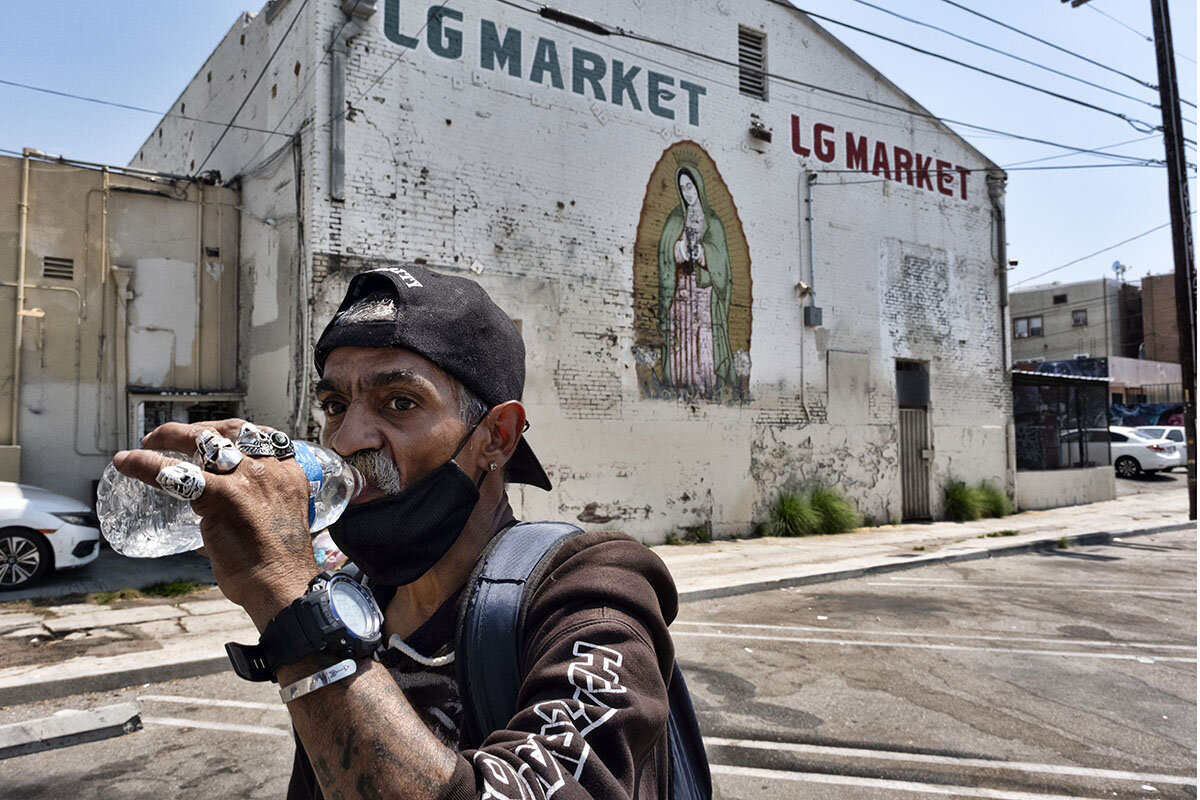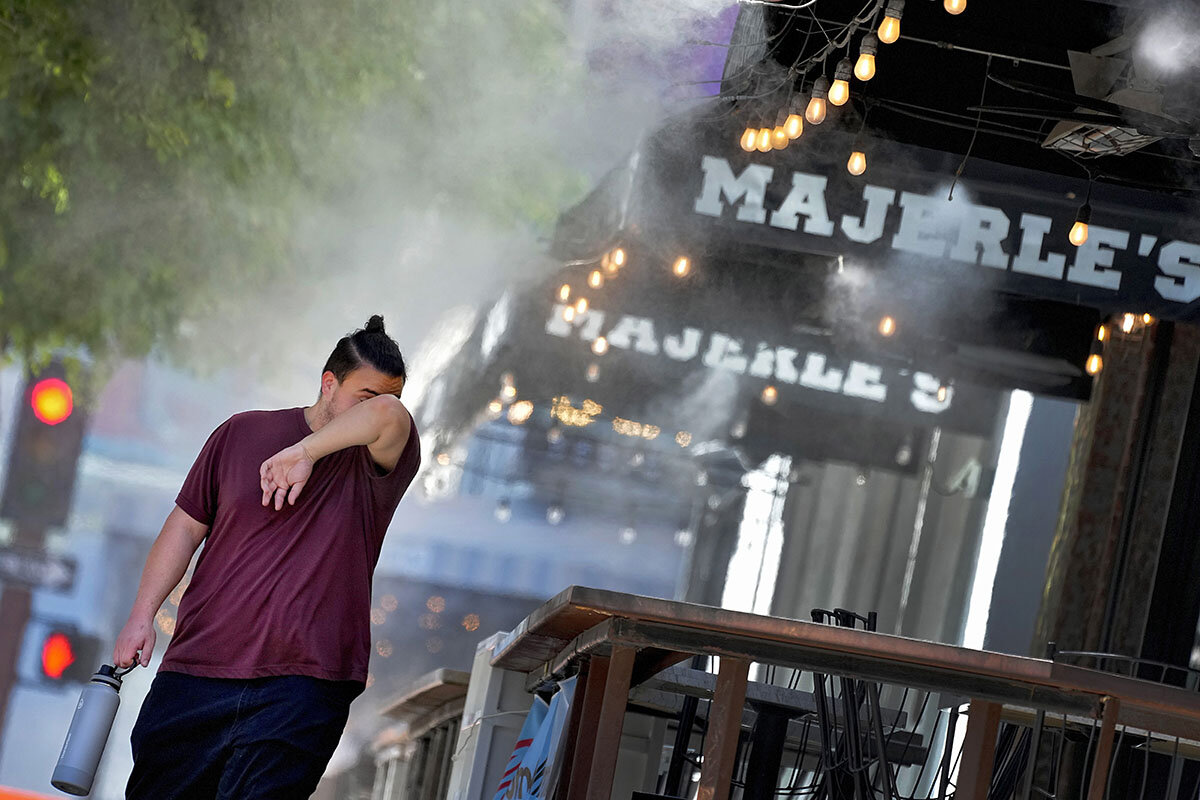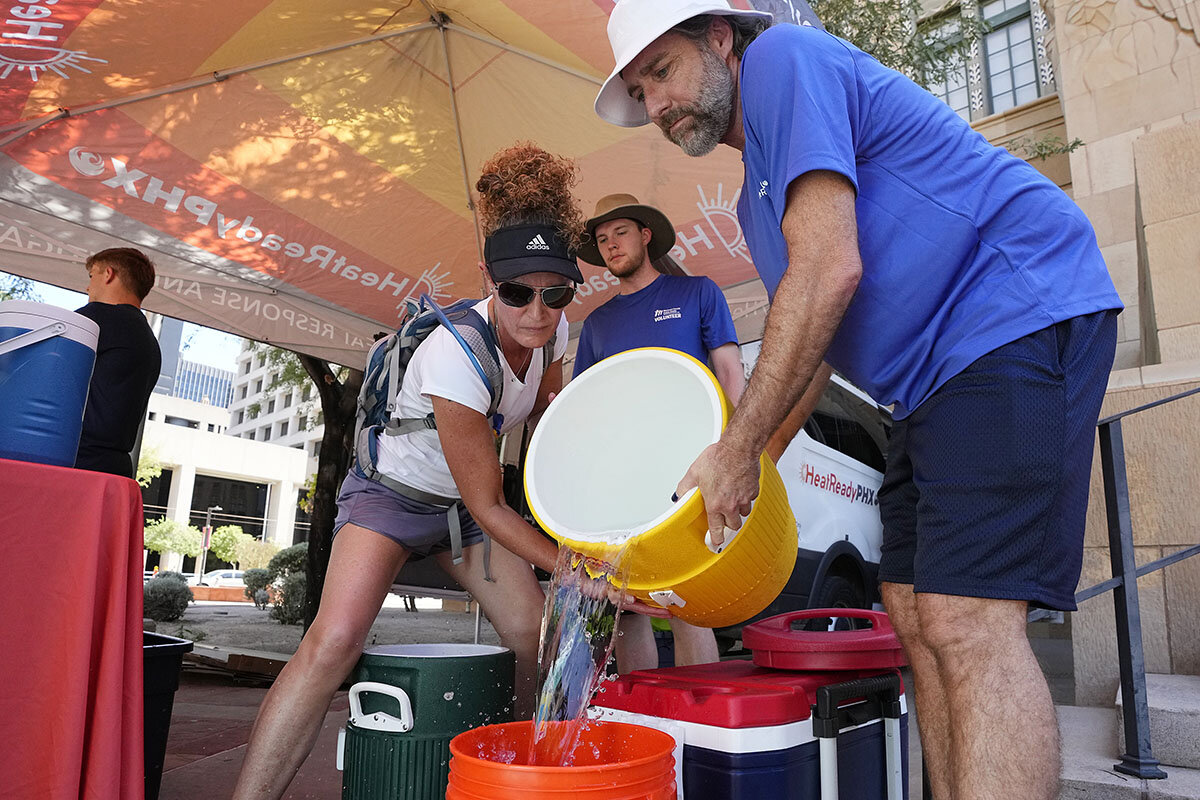- Quick Read
- Deep Read ( 7 Min. )

Why is Christian Science in our name?
Our name is about honesty. The Monitor is owned by The Christian Science Church, and we’ve always been transparent about that.
The Church publishes the Monitor because it sees good journalism as vital to progress in the world. Since 1908, we’ve aimed “to injure no man, but to bless all mankind,” as our founder, Mary Baker Eddy, put it.
Here, you’ll find award-winning journalism not driven by commercial influences – a news organization that takes seriously its mission to uplift the world by seeking solutions and finding reasons for credible hope.
Explore values journalism About usMonitor Daily Podcast
- Follow us:
- Apple Podcasts
- Spotify
- RSS Feed
- Download
TODAY’S INTRO
In Trump documents case, issue of loyalty is striking
The tension in Washington’s hot summer air is thick. Reporters have been staking out the federal courthouse, awaiting an indictment of former President Donald Trump over his alleged efforts to overturn the 2020 election. At the White House, there’s new stress over Hunter Biden’s legal woes, which carry high stakes for his father, President Joe Biden.
But late Thursday, a different federal indictment landed: new charges against Mr. Trump in the case involving his retention of classified documents at his Florida estate. Property manager Carlos De Oliveira was also indicted for taking part in an alleged plot to delete security footage.
Mr. Trump faces three new charges: attempting to “alter, destroy, mutilate, or conceal evidence”; inducing another person to do the same; and willfully retaining a classified national security document, this one at his club in New Jersey.
The ex-president now faces 32 counts of illegal retention of classified documents and eight counts of obstruction. That trial is scheduled to start next May, though delays seem likely – possibly until after the 2024 election.
On a human level, the issue of loyalty in the documents case is striking. In the new charges, another Trump aide under indictment, Walt Nauta, is said to have asked a valet about Mr. De Oliveira’s loyalty to Mr. Trump. The response: He “would not do anything to affect” their relationship. The ex-president then reportedly offered to get Mr. De Oliveira a lawyer.
Both Mr. Nauta and Mr. De Oliveira stand accused of serious charges. Some legal experts have questioned why, so far, neither man has “flipped.”
Such loyalty could stem from personal affection or views about the case’s merits. But Mr. Trump is also the leading candidate for the Republican nomination. If he retakes the White House, he could potentially pardon himself, along with anyone else.
Share this article
Link copied.

Help fund Monitor journalism for $11/ month
Already a subscriber? Login

Monitor journalism changes lives because we open that too-small box that most people think they live in. We believe news can and should expand a sense of identity and possibility beyond narrow conventional expectations.
Our work isn't possible without your support.
Heat czars, trees: Relief for urban heat islands
July is shaping up to be the hottest month ever recorded for the planet. In the U.S., cities are showing a greater awareness, ramping up to deal with heat, especially in marginalized communities.

For 12 nights in a row, The Mission at Kern County shelter has been filled to capacity. That’s unusual for summer months in Bakersfield, California, where many of the city’s unhoused residents tend to sleep outdoors during the warm nights. But Bakersfield’s warm nights have become unbearably hot.
“People can sleep outside if it’s a summer night, 80 degrees, 78 degrees,” says Carlos Baldovinos, The Mission’s executive director. “But if it gets [as] hot as we’re seeing ... over 100 degrees, people don’t want to be out there because at night it’s hot, too.”
July is shaping up to be the hottest month ever recorded on the planet. The extreme heat is especially challenging in dense urban areas, where temperatures are exacerbated by concrete pavement, tall heat-retentive buildings, and a lack of shady greenery.
These urban heat islands are testing resources put in place over the last few years – Phoenix, Miami, and Los Angeles are leading the way with city heat officers – but across the country, state and local governments are also bolstering programs and services. President Joe Biden on Thursday announced his own plan to help people deal with heat.
“There’s been a shift in awareness of heat at the decision-maker level,” says Ladd Keith, an expert in urban planning and climate change at the University of Arizona who co-wrote a report on how cities can adapt to rising temperatures.
Heat czars, trees: Relief for urban heat islands
For 12 nights in a row, The Mission at Kern County shelter has been filled to capacity. That’s unusual for summer months in Bakersfield, California, where many of the city’s unhoused residents tend to sleep outdoors during the warm nights. But Bakersfield’s warm nights have become unbearably hot.
“People can sleep outside if it’s a summer night, 80 degrees, 78 degrees,” says Carlos Baldovinos, The Mission’s executive director. “But if it gets [as] hot as we’re seeing ... over 100 degrees, people don’t want to be out there because at night it’s hot, too.”
Hot, arid Bakersfield sits in the western margin of a record-breaking heat wave that spreads across the United States. Phoenix is making headlines for its record duration of days over 110 degrees – 29 as of Friday. Las Vegas has been running 4 degrees above seasonal averages lately. Though many cities may see some relief in coming days, the heat wave currently stretches from Texas, in the low 100s, into the rest of the South; heat advisories run throughout the Midwest and along the East Coast, from Virginia through New Hampshire.
Sweltering, unrelenting heat has come to define this summer, with July shaping up to be the hottest month ever recorded for the planet. It’s especially challenging in dense urban areas, where temperatures are exacerbated by concrete pavement, auto emissions, tall heat-retentive buildings, and a lack of greenery offering shade.
These urban heat islands are testing resources put in place over the past few years – Phoenix, Miami, and Los Angeles are leading the way with city heat officers – but across the country, state, regional, and local governments are also bolstering programs and services. President Joe Biden on Thursday announced his own plan to help people deal with heat. In these efforts, leaders have their eye on permanently higher temperatures and the dangers they bring, especially for the country’s most vulnerable people.

“There’s been a shift in awareness of heat at the decision-maker level,” says Ladd Keith, an expert in urban planning and climate change at the University of Arizona who co-wrote a report on how cities can adapt to rising temperatures.
In addition to Phoenix’s heat officer, for instance, government agencies in surrounding Maricopa County coordinate with services on the ground to administer help – and listen. “We have a sustained network now of nonprofit, social service providers, and faith-based organizations that are in touch with many of the most vulnerable in our community and can ensure that we’re providing support to the right people, but also give us feedback on what we should be doing to make sure that we’re providing the right support in the future,” says Dr. Keith.
Chillin’ by the AC vent
Back in Bakersfield, it’s 102 degrees at 6 p.m. when the public water park closes and Sirena Salazar packs up the birthday picnic she’s been enjoying with her children and best friend. “The water park cools us off for a minute,” says Ms. Salazar, who stays in a shelter at night with her three kids, and works full time during the day driving people to medical appointments.
The heat is a constant concern. “I’m coping with the summer,” she says, with a focus on her children’s daily needs.
Coping means visiting pools or tree-shaded parks whenever they can. At night, 12-year-old Karalynn Salazar tries to keep her older siblings from taking her spot on the top bunk, closest to the air-conditioning vent. “So all of them are hot and I’m just over there chillin’ in the AC,” says Karalynn.
Bakersfield is like other cities that have intense heat concentrated at its urban core. Eighty percent of Americans live in urban areas – 41 million of whom live in urban heat islands, where low-income and vulnerable communities also tend to be overrepresented.

Those vulnerable residents have no choice but to endure the heat, says Guangqing Chi, a professor of sociology, demography, and public health at Pennsylvania State University who studied the effects of city planning on urban heat islands. Wealthier residents “may have a seasonal house or may be able to go someplace cooler,” says Dr. Chi. “But these people ... they are kind of stuck where they are.”
A visit to the interactive heat map by the University of California, Los Angeles shows that Bakersfield’s Kern County has an average 126 additional heat-related emergency-room visits on days with extreme heat, which experts point out is responsible for more deaths than any other extreme weather event.
A city responds
The heat map is one of the tools informing Los Angeles’ Climate Emergency Mobilization Office, launched last year to implement equitable solutions to climate-related needs. “Heat has been the silent killer or the silent contributor to excess hospitalizations and excess mortality, and we feel [that’s] preventable,” says Marta Segura, LA’s inaugural chief heat officer and director of the emergency center. Ms. Segura is tasked with coordinating resources across government offices, organizations, and community groups to streamline messages to the public and harness and implement ideas.
As temperatures rise, the emergency center deploys resources where they’re most needed, and connects with residents through websites and apps like Cool Spots LA. The strategy seems to be working: LA added more cooling centers to low-income neighborhoods and saw more than a tenfold increase over 2020 in people using them.
“We have seen more people using our resources,” says Ms. Segura, who adds these resources are diverting health problems. “It’s not easy to leave your home and make the trek to a city facility to stay cool. So we feel those people who come really, really need this.”
Other efforts underscore the city’s comprehensive approach to extreme heat: tree planting programs, subsidies for energy efficiency and air conditioners, and links to funding for grassroots projects that combat or adapt to climate change; plus interactive tools that allow residents to track heat-related issues like air pollution and to see which communities are benefiting from public investment.
These efforts are consistent with a growth in heat resources across the country, which parallel a growing recognition of a climate emergency. But experts agree it’s not enough. “Every city in the world should be planning for heat,” says Dr. Keith, who adds that strategies will look different depending on local risks. “If they’re historically a hot location, they’re going to have to plan for chronic heat. .... If they’re a cooler, temperate location, they may have to focus more on what they do during an extreme heat event that may come suddenly.”

Cities like Boston, New York, and Baltimore don’t have designated heat officers, but manage extreme heat through related offices like emergency services or health departments. Thousands of other municipalities across the country lack plans or resources to address extreme heat events. But the participation of every community is essential if strategies to combat extreme heat are going to be successful, says Dr. Chi from Penn State. “The solution is there,” he says. “We really need the entire society, individuals, communities, all levels of government, different sectors of the economy, and even globally. ... Nobody can say, this has nothing to do with me. Everybody is affected.”
United efforts
California has long been unified on a need to address climate policy. The state Office of Planning and Research was established to develop climate policies and regulations in 1970 – under Republican Gov. Ronald Reagan.
Decades later, this wave of extreme heat should make clear the need for more action to correct long-term climate change and find immediate relief from extreme heat, says the office’s director, Sam Assefa. If people don’t believe the science, they should believe their eyes, he says. “It’s happening right in front of you.”
Today, California agencies have access to unprecedented funding to address extreme heat and other climate issues. The state is in its second year of a $54 billion climate initiative aimed at reducing greenhouse gas emissions and extreme heat, fires, and floods. Add to that billions in federal funding through the bipartisan infrastructure act, and general bipartisan support in the state for prioritizing climate action.

The funding, science, and known solutions combine for a historic moment, says Mr. Assefa, who notes the considerable state and federal resources flowing toward climate and infrastructure. “The challenge is, how do we deploy those resources in the most effective ways to significantly minimize the impact in some cases and in certain areas reverse the trend” of global warming, he says.
Under Mr. Assefa’s purview, a new Extreme Heat and Community Resilience Program supports on-the-ground initiatives through targeted grants. Unincorporated communities in the Eastern Coachella Valley, for instance, received more than $644,000 to develop a plan for adding shade to low-income, Spanish-speaking neighborhoods where temperatures can exceed 120 degrees. Other cities like Stockton, San Fernando, and Lake Elsinore received hundreds of thousands of dollars each to create or update local climate adaptation plans.
Dealing with extreme heat is going to require city planners to channel their efforts in new directions, and especially in places that need them most, says Dr. Keith. “It will require new ways of planning our cities, new ways of operating our government, new ways of living our lives.”

Military pilots’ pivotal role in Israeli democracy battle
In democracy, the ideal is that the military stays out of politics, and vice versa. But with many Israelis seeing their democracy as wobbling, it’s a refined sense of duty that is compelling veteran pilots and other military reservists to act.

- Quick Read
- Deep Read ( 6 Min. )
-
By Danna Harman Contributor
For months, thousands of Israeli reservists from dozens of units, among them more than 1,100 from the air force, have repeatedly threatened to end their voluntary military service if the government pushed through its plan to overhaul the judiciary. On Monday, it passed the first law doing just that.
For many Israelis, it’s clear that if an institution exists that has leverage over what happens next, it would be the military.
“We pledged to serve the kingdom and not the king,” Eyal Nave, a reservist protest movement leader, said at a press conference last week.
Yoram Bouskila, a proud combat helicopter pilot and father of four, has served in the Israeli air force for practically all his adult life, as a fighter, an instructor, and a volunteer reservist at headquarters. He wasn’t done, but this week he called it quits.
“It makes me cry,” he admits. “But we are on the edge of the abyss, and it’s my duty to do everything in my power to prevent us from falling in. ... My decision is not about politics. It’s about the rules of the game. They have been changed on us, and I am not prepared to serve a dictatorial, illegitimate regime.”
Military pilots’ pivotal role in Israeli democracy battle
Yoram Bouskila is an air force man.
A combat helicopter pilot, he started his training at age 18. Today, nearing 60, Mr. Bouskila has served in the Israeli air force for practically all his adult life, as a fighter, an instructor, and a volunteer reservist at headquarters.
A few years ago, the father of four, a classically trained musician who invests in clean tech, did a two-year stint at the helm of the Friends of the IDF (Israel Defense Forces) chapter of New England, a role he took on while his wife was at Harvard getting her MBA.
He is, he says, “an Israeli citizen, a Zionist, and a Jew,” with an identity tied up, thoroughly, with the air force. He is a lieutenant colonel. A proud one.
And this week he called it quits.
He did so after watching Israel’s hard-right government push through a law Monday limiting the power of the Supreme Court to review government actions, a move denounced by critics as undermining Israeli democracy.
“It makes me cry,” he admits. “I love the air force and was planning to be involved for years to come. But we are on the edge of the abyss, and it’s my duty to do everything in my power to prevent us from falling in.
“I have served this country for nearly 42 years – following orders from different governments and taking part in every war and operation I was sent into. My decision is not about politics. It’s about the rules of the game. They have been changed on us, and I am not prepared to serve a dictatorial, illegitimate regime.”
Reservists at the front
Mr. Bouskila is not alone.
In recent months, more than 10,000 reservists from dozens of units, among them more than 1,100 from the air force, have publicly and repeatedly threatened to end their volunteer military service if the government pushed through its plan to overhaul the judiciary.
The military – which Israelis like to think of as a body above politics – has clearly been drawn into the roiling conflict. It also seems clear to many that if an institution exists that has leverage over what happens next, it would be the military.
“We pledged to serve the kingdom and not the king,” Eyal Nave, a leader of the Brothers in Arms reservist protest movement, said at a press conference last week ahead of the Monday vote in parliament.

In the lead-up to the vote, everyone from former heads of the Mossad and Shin Bet security services to the current military chief of staff, Lt. Gen. Herzi Halevi, warned that the internal military situation could get out of hand.
The areas about which they expressed concern ranged from cohesion among the ranks, to the IDF’s general preparedness, to lowering morale among active-duty soldiers and disincentivizing youngsters from volunteering for top units.
Ten former air force chiefs released an open letter calling on Prime Minister Benjamin Netanyahu to work out a solution to the crisis. “We are fearful over ... the serious and tangible danger posed to the national security of the State of Israel,” the letter said.
Then on Monday, the law passed – leaving everyone holding their breath to see if these military threats were just bluster and pressure tactics – or if the reservists would follow through.
So far, according to two pilots involved, who spoke on condition of anonymity, only a “trickle” of reservists have taken the formal step needed and informed their commanders they would not be showing up for training. But, say the pilots, something has indeed been “broken,” and more resignations are sure to follow in the days and weeks to come.
“There will always be platitudes about keeping the military out of politics. But the reality is that the military leadership ... are massively opposed to the authoritarian inclinations of this government,” says Dan Perry, former Mideast chief for The Associated Press and today a regional affairs analyst. “Realistically they are also opposed to the broader strategic positions this government represents, first and foremost the occupation and colonization of the West Bank.
“If the pilots and other reservists who threatened to quit make good on their threat, the cost to Israel’s security – to its military readiness – will be dire,” he says. “That this ‘own goal’ is happening can only be a wonderful surprise and an extraordinary gift to the enemies of Israel – an utterly self-inflicted disaster.”
A reliance on volunteers
In Israel, military service is mandatory for most people, as is, in many cases, reserve duty up to a certain age, depending on one’s rank, role, and unit. After these years of duty, however, many Israelis – in some units over 50% by some accounts – continue to serve the country in a volunteer capacity.
Pilots, who train for three years and serve a mandatory tenure of 10 more in their squadrons, often remain in voluntary service for years after, training a day every week to maintain their operational readiness and taking part in missions.
It is accepted wisdom that the military is heavily reliant on these experienced volunteers – and that reserve pilots and navigators are regularly called upon for missions.
“The [pilots’] threat is a double-edged sword,” says Mr. Perry. “On the one hand, it shows how high the cost of authoritarianism will be in Israel. On the other, though, it made the coalition even more determined to not be seen as giving in to blackmail by security people, which can be presented as a sort of ‘coup.’ It might have backfired in a way.”
Backfired for now, he clarifies – but nonetheless potentially effective going forward.
“One possible outcome,” says Mr. Perry, “is that the coalition pockets what will be sold to its base as a huge victory and then doesn’t risk such a recklessly high cost” by pursuing further pieces of its judicial overhaul.
Among those pieces are changes to the selection process for Supreme Court justices and giving parliament the power to override the court with a simple majority vote. Opponents see the judicial overhaul as opening the way for Mr. Netanyahu’s far-right and ultrareligious allies to impose their worldview on the rest of society.

Pilots under fire
Mr. Netanyahu has called on the reservists to keep out of politics but also has been dismissive of their threats – saying he’s willing to shut down “a few squadrons” in order to continue with the overhaul legislation.
Others in his party have gone far further, calling the reservists everything from anarchists to traitors.
And, in a move sharply condemned by the IDF spokesperson, several coalition members, including National Security Minister Itamar Ben-Gvir, reposted on Facebook a fictitious propaganda video in which pilots withhold combat support from ground troops who refuse to condemn the overhaul. The pilots fly away, leaving those below to be killed by enemy combatants.
“My brothers, on the left and the right,” whispers a dying soldier who called for air support. “Don’t bring politics into the army.”
Finance Minister Bezalel Smotrich wrote on Facebook, “A country that gives in to the threats of generals will actually become a country ruled by a military junta, and that is the furthest thing from a democracy.”
Fueling the furor over such remarks, Mr. Ben-Gvir never served in the military, and Mr. Smotrich only did short service in a noncombat role.
Maj. Gen. Tomer Bar, the air force commander, hit back, saying such statements “have no place in society and ... cause great damage to the cohesion of the force.”
The establishment line
This is not the first time Israeli pilots have sought to influence policy – but the scale is unprecedented.
In September 2003, a group of 27 pilots sent a letter to Dan Halutz, the air force commander then, in which they refused to fly operations endangering Palestinian civilians, such as missions targeting militants in the West Bank and Gaza even as they moved near crowds.
Back then, the establishment, all as one, turned on what was dismissed as a “marginal, small group.” The chief of staff decried their “illegitimate” statements.
Even more telling, hundreds of other pilots then signed a counterpetition denouncing those who had refused to serve – causing a few of the original group to backtrack. Protest leaders and others were suspended by Major General Halutz.
Today, those threatening to stop serving the country are not only many more in number but include the establishment. One of the leaders of the current protest movement is none other than Mr. Halutz himself.
“The government is declaring war against the character and values of the State of Israel, and we won’t let this happen,” he said. “We won’t let the darkness descend upon us.”

Podcast
Lessons in helping Malawi’s girls help themselves
Putting a human face on some cold poverty data started our writer on a nearly two-decade quest to understand how help, given thoughtfully, can be transformative and lasting. It starts with humility: knowing what you don’t know.

A data point can often seem impersonal. But get to know the people behind it, and the picture changes entirely.
Writer Xanthe Scharff discovered that through a story that took root almost two decades ago. In 2005, Xanthe profiled a Malawian family to help readers understand what it meant to live on $1 a day – in extreme poverty. Readers’ connection and compassion were immediate – as were donations that helped Xanthe found the nonprofit Advancing Girls’ Education in Africa (AGE Africa).
On a recent return trip for another story, she reflected on the initial story’s many lessons – including the power of listening.
At the beginning, “I was so aware of what I didn’t know. It was natural for me to listen to our Malawian partners and colleagues,” Xanthe says. “Our country directors knew best how to help the girls, and I learned that I knew how to organize a U.S.-based nonprofit and unlock financial resources.”
As AGE Africa grew, she listened for what the girls were facing – and the “boundaries of help.”
“What are the situations where there isn’t really a way to help,” asks Xanthe, “and the best we can do is listen ... and support choices in agency they’re making?”
And then, she listened for when to step aside.
As Madalo Samati, who worked with Xanthe, puts it: “This is a story that oftentimes is missing in this part of the world. ... I tell [Xanthe] how she inspires me that she was able, after 10 years, to leave AGE Africa in able hands, trusting that those people will continue her vision and grow it.” – Amelia Newcomb and Jingnan Peng
You can find links to to the stories discussed, and a transcript of this episode, here.
Sowing Agency in Malawi

This Frenchman builds community, letter by letter
At a time when letter writing has gone the way of the quill pen, a self-appointed bicycle delivery messenger and his team are helping to build the social bridges the digital world threatens to tear down.
- Quick Read
- Deep Read ( 5 Min. )
Vincent Berthelot does not work for the French postal service. But the retired teacher has traveled more than 9,000 miles by bike, hand-delivering letters across France.
In July 2015, he took his maiden voyage, with 66 envelopes in his yellow bike pouch.
“Each time I deliver a letter, it’s a story, a life,” says Mr. Berthelot. “At first, people are stupefied. They can’t understand how I got there, how I went across the country with a letter just for them.”
What Mr. Berthelot does is a throwback to a time that no longer exists, says Marie Chiron, who worked for the French postal service for 35 years.
“We used to knock on the door. ... People would invite us in for coffee, or ask us to pick up something at the bakery or the pharmacy for them,” says Ms. Chiron. “People had a real fondness for the mail carrier.”
His role as the surprise messenger has a power to break down barriers. Clément Bouju, a farmer, asked Mr. Berthelot to deliver a letter to his father just before becoming a father himself.
“[My father and I] never talk about intimate things or emotions,” says Mr. Bouju. “It’s still hard for him to open up, but that letter allowed us to finally talk about certain things.”
This Frenchman builds community, letter by letter

“Bonjour, Nathalie. ... Bonjour, Blandine. ... Bonjour!”
A morning stroll through Redon, France, with Vincent Berthelot is like walking with a local celebrity. In this Breton town, at the crossroads between the Vilaine and Oust rivers, flower boxes line the bridges and a Gothic-era bell tower chimes on the hour. And nearly everyone pauses to say hello and exchange bises, or kisses.
He’s not the mayor, an actor, or an influencer. The retired teacher has created his own hobby/part-time job: person-to-person letter carrier.
But Mr. Berthelot does not work for the French postal service. He never has. In 2014, on the eve of his retirement, Mr. Berthelot got the idea to cross France on his recumbent bike for three months. But he wanted to do so with purpose. What if he delivered letters on the way?
In July 2015, he took his maiden voyage. With 66 envelopes in his yellow bike pouch, he set off across the country to deliver hand-written letters to friends of friends and soon-to-be new ones. The cardinal rule? No mailboxes allowed. Mr. Berthelot delivers all the letters personally.
“Each time I deliver a letter, it’s a story, a life,” says Mr. Berthelot, a sprightly 60-something who is quick to smile. “At first, people are stupefied. They can’t understand how I got there, how I went across the country with a letter just for them.”
Despite their shock, Mr. Berthelot says people rarely show him the door. He’s often invited in for something to drink and sometimes is asked to stay the night. He usually brings a tent with him, but he says he only puts it up about one-third of the time.
Through his acts of kindness, Mr. Berthelot has not only built unlikely relationships for himself but also helped family members reconnect and rekindle long-lost friendships. He’s even inspired others to join him in what is now a nearly 100-person-strong collective. At a time when letter writing has gone the way of the quill pen, le facteur humain – the human factor, as Mr. Berthelot is dubbed – and his team are helping to build the social bridges the digital world threatens to tear down.
“With social media, our interactions are one-sided. It’s easy to look away from someone who disagrees with us instead of finding common ground,” says Carole Gayet-Viaud, a researcher on civility and social norms at the French National Centre for Scientific Research in Paris. “More and more, we’re finding ourselves in spaces that are compartmentalized and closed off from one another, which affects our definition of reality.”
“It’s great to surprise someone”
Gwenola Furic was one of the first people with whom Mr. Berthelot shared his initial idea and is one of his most prolific writers. Ms. Furic says there’s something about letter writing that allows her to communicate more lasting thoughts and emotions than through email.
“When Vincent told me about his project, I thought it was awesome,” says Ms. Furic, who has invited Mr. Berthelot to her photo restoration studio in Redon to give him a new letter to deliver. “It’s great to surprise someone, a person I haven’t seen in a long time. If we didn’t write these letters, we’d lose touch.”
Mr. Berthelot chooses his route based on the letters he receives, but people also inquire about his plans and look for people they can write to based on his destination. A few years ago, Ms. Furic wrote a letter to a long-lost family friend in Switzerland, after learning that Mr. Berthelot would be heading in that direction.

“He took a while to understand because it’s just not normal for someone to show up at your doorstep with a personalized message,” says Mr. Berthelot of his encounter with Ms. Furic’s friend. “But when it finally registered, he went into his room and came back down with a photo that Gwenola had given him as a kid, that he’d kept in his bedside table.”
Some of these intimate moments were captured in 2018, when filmmaker Alexandre Lachavanne accompanied Mr. Berthelot for 800 kilometers – 500 miles – of a trip between Redon and Switzerland. By then, Mr. Berthelot had clocked more than 9,300 miles on his bike and delivered 230 letters. He has since stopped counting.
In 2020, he self-published a book about his encounters. While people confide in him stories of love affairs and family secrets – even illegal acts – he’s tight-lipped about what he hears, likening himself to “something between a psychologist and a priest.”
His role as the surprise messenger has a power to break down barriers. Clément Bouju, a local vegetable farmer, asked Mr. Berthelot to deliver a letter to his father just before becoming a father himself. It has since opened a channel for communication.
“We’ve always been in touch but we never talk about intimate things or emotions,” says Mr. Bouju. “It’s still hard for him to open up, but that letter allowed us to finally talk about certain things.”
The human touch
How is Mr. Berthelot’s mission different from the regular postal service? For starters, it aims to be 100% no-carbon. He and his team are committed to taking routes on bike or foot, whenever possible. Moreover, “I’m the human delivery service,” says Mr. Berthelot. “The post office is no longer a human affair.”
What he does is a throwback to a time that no longer exists, says Marie Chiron, who worked for the French postal service for 35 years before retiring in 2009.
“We used to knock on the door, and if no one was home, we’d open the door and leave the letter on the table,” says Ms. Chiron, who comes to sit with Mr. Berthelot for a midmorning coffee on Redon’s main street. “Other times, people would invite us in for coffee, or ask us to pick up something at the bakery or the pharmacy for them. People had a real fondness for the mail carrier.”
Mr. Berthelot’s desire for human connection is infectious. Thanks to his initiative, there are now around 90 facteurs humains prepped to set off around the country – and beyond. One trip took a delivery person all the way to St. Petersburg, Russia, while a couple recently left for a three-year trip to Nepal, on foot, with someone’s letter in hand.
Even the younger generation is excited about connecting old-school. During an afternoon party in a nearby village, Mr. Berthelot’s 11-year-old grandson asks if his grandpa can deliver a letter to one of his friends from summer sailing school.
Back at home in a tranquil part of Redon, Mr. Berthelot and his wife of 42 years, Marie-Anne, take a break with homemade apple juice, their chickens squawking in a nearby cage. A neighbor sawing wood next door cuts the silence. Then, an email arrives.
It’s a woman who lives in southeastern France and wants a letter delivered this summer to someone near Carcassonne. With this, Mr. Berthelot’s back springs up straight, ready to pounce on this new mission.
“It only takes up one-third of my time,” says Mr. Berthelot, smiling.
“It’s a lot of organization,” says his wife, throwing her head back in a laugh. “More like half.”

In Pictures
Inside the fantastical world of an anime convention
Anime lovers at a convention in San Antonio, Texas, have realized that as much as they enjoy the genre, it’s the community they create that keeps them coming back.

- Quick Read
- Deep Read ( 3 Min. )
-
Henry Gass Staff writer
It’s clear from the panel titles that this conference is not like others. On offer: a health and fitness session called “How To Get a Dream Anime Body”; a Jeopardy-style trivia game, Are You Smarter Than a Shonai?; and a cosplay competition.
Welcome to Kawacon, an annual San Antonio convention for anime lovers.
Anime originated in Japan, but the genre’s popularity internationally has since overtaken domestic viewership. Some 3 billion people watched anime in 2021, according to one estimate. Only crime dramas and sitcoms are more popular right now, one analysis found.
Marissa Diaz travels to conventions year-round selling prints of anime artwork. She’s gotten to know some regular congoers, though sometimes she doesn’t recognize them in costume. “There’s no judgment,” she says. “It’s just a nerdy marketplace.”
Attendees say they enjoy seeing the hand-drawn animation and cosplaying (dressing up) as their favorite characters. But as much as anything else, they enjoy the community.
“I’m shy, but when I dress up, I can be more outgoing because I’m this different person,” says Lisa Jones.
Adds cosplay contestant Ese Usoro, rocking red-dyed hair and electric-blue contact lenses: “It’s just fun.”
Inside the fantastical world of an anime convention
Welcome to Kawacon, an annual San Antonio convention for anime lovers celebrating the genre and cosplaying (dressing up) as their favorite characters.
The genre originated in Japan, but anime viewership internationally has since overtaken viewership there. Upward of 3 billion people watched in 2021, according to one estimate. Only crime dramas and sitcoms are more popular right now, one analysis found.
Fans at “Kawacon 2023: 2 to Tango!” say they enjoy the hand-drawn animation; they enjoy the long, compelling plots and the complex characters. But as much as anything else, fans say, they enjoy the community.
“You meet so many people,” says Lisa Jones. “I’m shy, but when I dress up, I can be more outgoing because I’m this different person.”

Marissa Diaz travels to anime conventions year-round selling prints of anime artwork. She’s gotten to know some other regular congoers, although sometimes she doesn’t recognize them in costume. “There’s no judgment,” she says. “It’s just a nerdy marketplace.”
Like any convention, there’s a schedule of smaller sessions. Because this is an anime convention, the sessions include “How To Get a Dream Anime Body,” a panel on health and fitness; Jeopardy-style trivia game Are You Smarter Than a Shonai?; and a cosplay competition.
Ese Usoro and Isa Florendo are here competing in their first cosplay contest. Ms. Florendo, in a white costume with a white papier-mâché monster fixed to her back (Yuta from “Jujutsu Kaisen”), knows what she did wrong. “I didn’t talk [with the judges] about everything,” she says. “My voice was shaking. I got nervous.”
Ms. Usoro has yet to go in, but her costume is getting lots of compliments outside the judges’ room. Two yoga balls, covered in papier-mâché, are strapped to her back. Her hair is dyed red. She’s wearing electric blue contact lenses.
Their characters, like pretty much every character in anime, deal with trauma. A globally traumatic few years may be a factor in anime’s recent surge in popularity, but Ms. Usoro has her own reasons. “It’s escapism, for me. ... [It] lets you get out of the world you’re in,” she says.
“One, it tests your creative skills,” she adds. “Two, it’s just fun.”







Other headline stories we’re watching
(Get live updates throughout the day.)The Monitor's View
The hunt to capture ‘boundless’ generosity
- Quick Read
- Deep Read ( 2 Min. )
-
By the Monitor's Editorial Board
It’s tough to measure the infinite. No, not the infinity of outer space. Rather, the inner space of people’s generosity. In a few months, a U.S. national panel known as The Generosity Commission plans to issue a report that’s expected to rip up old notions of giving – whether in treasure, time, or talent – and reveal how everyday Americans are re-imagining generosity and expanding its seeming boundaries.
Set up two years ago in the face of declines in current measures of volunteering and financial gift-giving, the 17-member commission has already made one discovery. In a poll last year, most people not only identified as generous but also described generosity as “boundless,” not confined to traditional charities, organized religion, or philanthropy.
One premise for the commission’s work is that generosity is ever-present. The new research is finding that this form of selfless love is hardly stagnant or limited. In fact, one report may not be enough to better measure generosity or to capture its future.
The hunt to capture ‘boundless’ generosity

It’s tough to measure the infinite. No, not the infinity of outer space. Rather, the inner space of people’s generosity. In a few months, a U.S. national panel known as The Generosity Commission plans to issue a report that’s expected to rip up old notions of giving – whether in treasure, time, or talent – and reveal how everyday Americans are re-imagining generosity and expanding its seeming boundaries.
Set up two years ago in the face of declines in current measures of volunteering and financial gift-giving, the 17-member commission has already made one discovery. In a poll of 2,569 adults last year, most people not only identified as generous but also described generosity as “boundless,” not confined to traditional charities, organized religion, or philanthropy.
“Generosity ranged from taking in a stray dog to helping a loved one with housework to buying water for teachers on strike to giving to a [registered charity],” researchers found. “People understand generosity as the multitude of thoughtful and helpful ways we interact with each other and the world around us.”
Giving to others first “comes from the heart,” the survey found, with 61% of people saying that generosity is “how they express their values.” With values being infinite by nature, new expressions of giving are always popping up.
For example, people now round up at the grocery store check-out to give. They form mutual aid societies to meet health needs. Platforms like GoFundMe and DonorsChoose have raised billions for people in need. The list even includes ethical shopping, advocating for civic causes, and parents’ providing a bedroom for a low-income adult child.
In a 2020 survey by Stanford University, less than 20% of Americans saw giving as a matter of money. They regarded generosity as “myriad informal” acts of kindness and connecting. The hypothesis of the research: Individuals give in more ways than even they understand. And they “are not primarily motivated by or looking for external validation or incentives.”
One premise for the commission’s work is that generosity is ever-present. The new research is finding that this form of selfless love is hardly stagnant or limited. In fact, one report may not be enough to better measure generosity or to capture its future.

A Christian Science Perspective
Each weekday, the Monitor includes one clearly labeled religious article offering spiritual insight on contemporary issues, including the news. The publication – in its various forms – is produced for anyone who cares about the progress of the human endeavor around the world and seeks news reported with compassion, intelligence, and an essentially constructive lens. For many, that caring has religious roots. For many, it does not. The Monitor has always embraced both audiences. The Monitor is owned by a church – The First Church of Christ, Scientist, in Boston – whose founder was concerned with both the state of the world and the quality of available news.
The ‘ghostbusters’ that free us from grief
- Quick Read
- Read or Listen ( 2 Min. )
-
By Randal Craft
We can always turn to God for inspiration that transforms our concept of life and lifts grief.
The ‘ghostbusters’ that free us from grief
I had just walked outside a building one day when I began to feel quite sad over the passing of a loved one. The thought came to me, “Who am I going to call?” Almost immediately, this answer came, echoing a familiar song: “Ghostbusters!”
It brought a moment of levity, and then I began to consider that this unexpected thought might also bring meaningful help. I realized that I could see those thoughts of sadness as “ghosts” – illusions or deceptions suggesting that life is volatile and can be terminated.
Christian Science explains that life is not based in matter – that everyone’s true being is in God, our divine Parent. We are truly God’s offspring – spiritual, not material – each of us a unique, immortal idea of God, the one divine Mind. As such, life cannot be lost. None of the wonderful spiritual qualities that make up our true identity – beauty, joy, intelligence, goodness, love, kindness, unselfishness, tenderness, holiness, just to name a few – can be lost.
And Mary Baker Eddy, who discovered Christian Science, states, “Truth, Life, and Love are a law of annihilation to everything unlike themselves, because they declare nothing except God” (“Science and Health with Key to the Scriptures,” p. 243). Truth, Life, and Love are Bible-based names for God.
So all truth originates in God, including the truth that all the good qualities we express originate in God – are found in Him – and are therefore eternal.
God is the only Life – the source of all true being, which is fully spiritual and eternal, not material and limited. As His children, we reflect that unlimited, eternal Life.
And God as Love always cares for each of His offspring, which includes everyone, and is holding us close right now – we can never be separated from Him.
These ideas gave me a better glimpse of spiritual reality – they were my “ghostbusters,” so to speak, breaking through the deception that life is in matter and can be lost. In fact, I was freed from grief that very day.
The ever-present power of God is always with us to strengthen us and lift us into a better understanding of true life as originating in God, and upheld by infinite Life. Even if grief tries to enter our heart, we can call on the “ghostbusters” – seek inspiration from divine Truth, Life, and Love – and find lasting comfort and healing.

Viewfinder
Cart with a good kick

A look ahead
Thanks for joining us today. On Monday, Howard LaFranchi will take a deeper look at how Israeli protests over judicial reforms – and their passage this week – are shaping Americans’ views of the country and challenging President Joe Biden.



